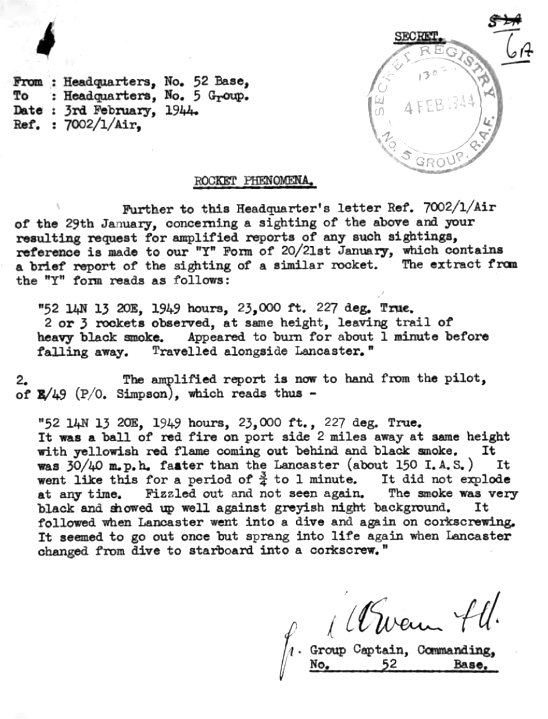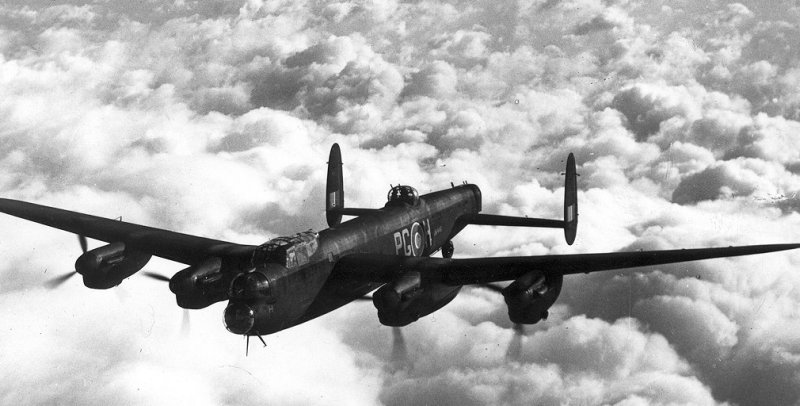ACUFO-1944-01-27-BERLIN-1
In his 2003 book "Strange Secrets" written with Nick Redfern, and his 2013 book "The UFO Files: The Inside Story of Real-life Sightings", Dr. David Clarke showed a report by No. 52 Squadron of the Royal Air Force (RAF), titled "AIR 14/2076: rocket phenomena" about a frightening aerial pursuit on the night of January 27, 1944; he explains that the commanding officer of 49 Squadron was so mystified by the account that he personally asked the pilot, Pilot Officer Simpson, to amplify his initial report so it could be forwarded to the Headquarters of No. 5 Group. His report read:
"At 52 32N 13 03E, 2037 hours, 20,500 ft., heading 082 True. A red ball leaving trail of yellow/red flames and black smoke at about 1,000 yards and at the same height dead astern. It was seen closing in. I dived to starboard and the object followed, appearing to fizzle out and then immediately to reappear. I turned hard to port and it followed us round in a tighter turn than we were in. When within 100 yards or less of the aircraft, it finally fizzled out."
Dr. David Clarke commented that while on the surface it sounded as though it could have been a very bright long-lasting type of meteor, bolide meteors do not chase aircraft.
The coordinates in the report indicate the incident occurred over Berlin, Germany.
| Date: | January 27, 1944 |
|---|---|
| Time: | 08:37 p.m. |
| Duration: | ? |
| First known report date: | January 29, 1944 |
| Reporting delay: | Hours, 2 days. |
| Country: | Germany |
|---|---|
| State/Department: | Berlin |
| City: | Berlin |
| Number of alleged witnesses: | 1 or more. |
|---|---|
| Number of known witnesses: | 1 |
| Number of named witnesses: | 1 |
| Reporting channel: | Military operation report and specific military report. |
|---|---|
| Visibility conditions: | Night. |
| UFO observed: | Yes. |
| UFO arrival observed: | ? |
| UFO departure observed: | Yes. |
| UFO action: | Approaches, follows plane despite evasive action, disappears when near plane. |
| Witnesses action: | Several evasive actions. |
| Photographs: | No. |
| Sketch(s) by witness(es): | No. |
| Sketch(es) approved by witness(es): | No. |
| Witness(es) feelings: | ? |
| Witnesses interpretation: | ? |
| Sensors: |
[X] Visual: 1 or more.
[ ] Airborne radar: [ ] Directional ground radar: [ ] Height finder ground radar: [ ] Photo: [ ] Film/video: [ ] EM Effects: [ ] Failures: [ ] Damages: |
|---|---|
| Hynek: | NL |
| Armed / unarmed: | Armed, 8 7.62 mm machine guns. |
| Reliability 1-3: | 3 |
| Strangeness 1-3: | 3 |
| ACUFO: | Possible extraterrestrial craft. |
[Ref. nrr1:] NICK REDFERN AND ANDY ROBERTS:
A secret document of January 29, 1944, titled "Rocket Phenomena" shows that reports of encounters with unknown aerial objects continued to be filed by Royal Air Force crews:
At 52 32N 13 03E, 2037 hours, 20,500 ft., heading 082 degrees True. A red ball leaving trail of yellow/red flames and black smoke at about 1,000 yards and at the same height dead astern. It was seen closing in. I dived to starboard and the object followed, appearing to fizzle out and then immediately to reappear. I turned hard to port and it followed us round in a tighter turn than we were in. When Within l 00 yards or less of the aircraft, it finally fizzled out.
[Ref. snu1:] "SATURDAY NIGHT UFORIA" WEBSITE:
This website indicates that an incident appeared in a January 29, 1944, report titled Rocket Phenomena of a pilot with 49 Squadron:
"At 52 32N 13 03E, 2037 hours, 20,500 ft. heading 082 degrees True. A red ball leaving trail of yellow/red flames and black smoke at about 1000 yards and at the same height dead astern. It was seen closing in. I dived to starboard and the object followed, appearing to fizzle out and then immediately to reappear. I turned hard to port and it followed us round to a tighter turn than we were in. When with 100 years [yards] or less of the aircraft, it finally fizzled out."
[Ref. dcr1:] DR. DAVID CLARKE:
This author indicates that a frightening aerial pursuit took place on the night of January 27, 1944; the commanding officer of 49 Squadron was so mystified by the account that he personally asked the pilot, Pilot Officer Simpson, to amplify his initial report so it could be forwarded to the Headquarters of No. 5 Group. His report read:
"At 52 32N 13 03E, 2037 hours, 20,500 ft., heading 082 True. A red ball leaving trail of yellow/red flames and black smoke at about 1,000 yards and at the same height dead astern. It was seen closing in. I dived to starboard and the object followed, appearing to fizzle out and then immediately to reappear. I turned hard to port and it followed us round in a tighter turn than we were in. When within 100 yards or less of the aircraft, it finally fizzled out."
The author comments that while on the surface it sounds as though it could have been a very bright long-lasting type of meteor; but bolide meteors do not chase aircraft, and these foo-fighter 'chases' were often of great duration.
The author indicates that the reference of the pilot's report is "AIR 14/2076: rocket phenomena", and he gives this report:

|
[Ref. nip1:] "THE NICAP WEBSITE":
[1944] Jan. 29, 1944; Location unknown
Red ball; yellow/red flames followed aircraft through evasive action. (Page 56 Ref.1)
The reference 1 is described at the end of the document as "Strange Company (2007), Keith Chester".
[Ref. tai1:] "THINK ABOUT IT" WEBSITE:
Date: Jan. 29, 1944
Location: Location unknown
Time:
Summary: Red ball; yellow/red flames followed aircraft through evasive action.
Source: Page 56 Ref.1
The Avro 683 Lancaster was a four-engine night bomber built in more than 7,000 units and it became, with the Handley Page Halifax, the main bomber of the Royal Air Force from 1942 on.
Its defense against German fighter planes was 8 7.62 mm machine guns.

|

|
The location is not given in plain text, but in coordinates, in [dcr1]: 52░ 32' North 13░ 03' East.
One then finds that the location was Berlin.
No. 49 Squadron was a bomber squadron of the Royal Air Force, operating Avro Lancaster long range night bombers in 1944.
It is entirely plausible that there were several witnesses to this sighting. The Lancaster had a crew of 7 men; they would certainly have all wondered about the motive for Pilot Simpson's evasive maneuvers. It was probably crew members other than the pilot who reported the presence of the light when it followed the plane, at such moments not visible to the pilot.
Historical sources indicate that this Lancaster of the 49th Squadron was registered EA-E. The pilot was John "Jock" Simpson. The navigator may have been Squadron Leader Jim Evans, or Squadron Leader Graham Day, or Denis Hiscock. The crew also included Frank Wheeler, Bob Mower, Arthur Highman, Colin Winterborn, Dennis "Johnny" Walker.
The phenomenon was obviously not a meteor. It must also be firmly said that the Germans, during the Second World War, never had any operational guided missile that would have been capable of following the evasive maneuvers of an aircraft. And as in the other cases of this period, the phenomenon never attacked the plane, which in any case makes the theories about German "secret weapons" to explain the "Foo-Fighters" totally unfounded, because what would be the sense of "secret weapons" that never caused any damage to the enemy?
Some suggestions were made at the time and still nowadays about Foo-Fighters being the exhaust flame of German jet fighters such as the Messerschmitt Me-262. Of course, the same remark applies: why did they never shoot at the enemy? But also, in this case as in may others, not only one light only is reported whereas the Me-262 had two engines (*), but also, the quite faint exhaust flame would only have been visible if the Me-262 flew in front of the witnesses planes, they could not have been visible when they followed, unless they would have flown head over heels.
(*) There were German jets with only one engine; but only the Me-262 was used in the night, and only from the Fall of 1944.
Possible extraterrestrial craft.
* = Source is available to me.
? = Source I am told about but could not get so far. Help needed.
| Main author: | Patrick Gross |
|---|---|
| Contributors: | None |
| Reviewers: | None |
| Editor: | Patrick Gross |
| Version: | Create/changed by: | Date: | Description: |
|---|---|---|---|
| 0.1 | Patrick Gross | October 13, 2023 | Creation, [dce1], [nip1], [tai1]. |
| 1.0 | Patrick Gross | October 13, 2023 | First published. |
| 1.1 | Patrick Gross | November 8, 2023 | Addition [nrr1]. In the Summary, addition of "his 2003 book "Strange Secrets" written with Nick Redfern, and". |